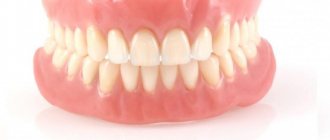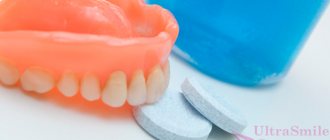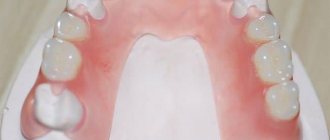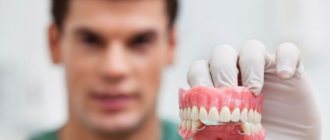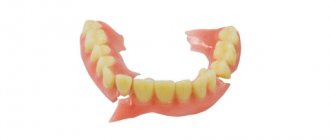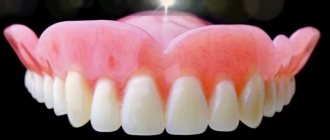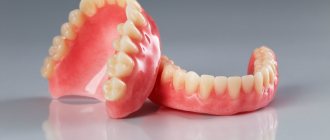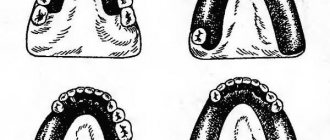21.11.2019
Modern dentistry allows patients not to worry about the loss of one or more teeth. Thanks to modern technologies, you can restore your smile without pain and without consequences. One of the innovations includes removable silicone dentures, reviews of which are mostly positive.
Content:
- Features and types of silicone teeth
- Who are they suitable for?
- Contraindications
- Advantages
- Flaws
- Manufacturing and installation
- How to extend product life
Silicone dentures are often used in dental practice.
With the help of these structures, it is possible to restore one or several damaged teeth at once. The systems are made according to individual impressions and are relatively inexpensive. Of course, they cannot be called the best solution for any clinical case of edentia, but doctors are often faced with situations where silicone structures are preferable.
Description of the procedure
If the patient does not have upper or lower teeth, dental prosthetics with silicone products is the best solution, especially if it is necessary to fill the missing front teeth. Such inlays are more expensive than traditional rigid structures, however, they look much more aesthetically pleasing.
Silicone or nylon dentures are most often used for partial dentures, since they are not very suitable for high chewing loads. During the initial examination, the dentist must select the most suitable design option that is suitable for this particular patient.
Manufacturing stages:
- Clinical (the patient, with the help of a doctor, selects the desired model, takes plaster impressions for subsequent transfer to a technical laboratory);
- Laboratory (casting a plaster model of the future prosthesis, delineating its boundaries, careful final modeling, plastering as for a conventional removable bridge, preparing nylon in a heat press and pressing it into all parts of the cuvette, processing the finished prosthesis with cutters, felts, brushes, devices for long-term polishing).
Features and types of silicone teeth
Restoring devices of the described type are always removable. They are suitable for partial and complete dentures. They are made of flexible and deformation-resistant material - nylon or Acry-free.
That is, silicone as such is not used in their production. The products were called silicone only because they outwardly resemble this frozen composition.
Soft devices have appeared in the field of prosthetics thanks to the introduction of innovative technologies for injection molding of polymers and medical plastics. To create them, specialists use high temperatures. It is through step-by-step heat treatment that the final product acquires the required degree of elasticity and strength.
Here are the names of the thermoplastics from which silicone devices are made:
- Nylon. Known to dentists for almost two decades. Very flexible material. Cheap solution for prosthetics.
- Acry-free (plastic without monomers). In addition to a soft base, Acry-free devices are equipped with a semi-rigid base. They are not as flexible as nylon, but last longer and wear better. Put less pressure on the gums.
According to the criterion of the number of missing teeth, silicone dentures are:
- Single. They are held in the dentition by special hooks - clasps. Only one tooth is replaced. They are placed if for some reason it is impossible to carry out prosthetics with fixed systems or implantation right now.
- Partial. Indicated if two or more adjacent teeth are missing. They are also kept in the mouth thanks to clasps.
- Full. Suitable for people with complete edentia (that is, when the dentition is completely empty). Can replace the upper or lower jaw. For high-quality fixation, they are “set” on special gels or creams that act as glue and do not allow food debris to get under the base.
How much does it cost to restore teeth?
How much do elastic removable dentures cost? The price depends on the material - its quantity and characteristics, on the manufacturing features. The cost of prosthetics may increase due to the use of silicone materials for taking impressions. For example, silicone mixtures (A-silicone in particular) are an order of magnitude more expensive than alginate ones. If we look at prices for flexible structures specifically by product type, then an “immediate butterfly” made of nylon costs from 20 thousand rubles, Acry-free – also from 20 thousand, Quattro Ti – from 32 thousand, and polyurethane – from 35 thousand rubles.
1Haug S., Correct modeling, 2006. 2Galonsky V.G., Radkevich A.A. Reaction of the mucous membrane of the supporting tissues of the prosthetic bed to the influence of removable dentures, 2009.
Author: Chernov A. R. (Thank you for your help in writing the article and the information provided)
Who are they suitable for?
Indications for the manufacture of silicone dentures are as follows:
- partial/complete adentia in adults;
- individual intolerance to removable acrylic dentures and impossibility of implantation;
- premature destruction of baby teeth in children.
Silicone devices are suitable for people who engage in extreme sports or have diseases of the pancreas or cardiovascular system. They do not oxidize and do not harm internal organs.
Indications and contraindications for the use of such structures
Dentists may suggest installing an elastic prosthetic structure for the following indications:
- absence of teeth (one or more),
- complete edentia,
- allergy to regular acrylic: the monomer contained in acrylic structures can cause irritation and swelling of the gums - especially if the manufacturing technology is not followed,
- when there are contraindications to fixed prosthetics: for example, in patients with decompensated diabetes mellitus, cardiovascular and endocrine pathologies, in children, pensioners, and during pregnancy.
Contraindications are the presence of mobile teeth (the prosthesis will loosen them until they fall out completely), as well as mental pathologies, when the patient may unknowingly swallow an artificial “jaw”. The presence of stomatitis and caries is also considered a contraindication, but a relative one - after treatment you can get prosthetics.
Advantages
A silicone dental prosthesis can easily be called a highly aesthetic dental device. It is practically invisible to others and makes the smile full and harmonious. Its flexible base is completely transparent or has a shade that matches the gum tissue. Other advantages of these devices include:
- Minimum weight, small volume. Thanks to these features, it is easier to get used to the prosthesis. It does not cause a feeling of heaviness in the chin area.
- Possibility to keep adjacent teeth intact. There is no need to grind them down to secure the structure. Modern clasps, made of a translucent base, are not visible when laughing and talking.
- Reliability. The retention systems of silicone prostheses are durable. Under no circumstances will they fall out of your mouth.
- Health safety. Modern flexible systems do not include monomers - compounds that often cause an individual intolerance reaction. Therefore, they can be safely used even by people prone to allergies to medical alloys and materials.
Advantages and disadvantages
These are highly aesthetic products that are practically invisible in the oral cavity. Their flexible part is translucent and painted in different shades of pink, thanks to which it merges with the mucous membrane. Silicone devices have the following advantages:
- Small volume and weight. This is how they differ from acrylic structures, which have a heavy frame of considerable thickness. The silicone base is 10 times stronger than acrylic or plastic. With the same characteristics, silicone products weigh much less than plastic ones and are highly comfortable.
- There is no need to grind adjacent teeth for installation. Like plastic dentures, silicone ones are fixed with clasps. But if the fastenings of the former are made of metal and are clearly visible when you smile, then for the latter they are made of translucent material. The clasps do not cover the teeth themselves, but the gums around them, so they are practically invisible.
- Reliability. The product is firmly attached to the mouth and does not fall out under any circumstances.
- Hypoallergenic. Unlike acrylic, silicone dental prostheses do not contain monomers that cause allergies.
But there are not only positive qualities, but also some disadvantages. Removable silicone dentures have the following disadvantages:
- The products are fixed using clasps, which can cause injury to the mucous membranes and subsidence of the gums.
- Since on one side of the jaw the prosthesis puts pressure on the mucous membrane and puts pressure on it, atrophic changes in the bone tissue can occur. But if the prosthesis is placed on one or two teeth, then such consequences are unlikely.
- Dentures cannot bear prolonged chewing loads, so many experts do not recommend placing them on the lower jaw.
- High price. Compared to its acrylic counterpart, silicone dentures cost up to 5 times more.
- It takes a long time to get used to wearing it.
- You will have to visit the dentist often, since the prosthesis cannot be polished, and its surface is rough; bacteria settle on it, causing plaque and an unpleasant odor. Plaque can only be removed in a clinical setting.
- The service life of the prosthesis is short.
Another negative property is associated with their softness. Thus, with acrylic and clasp devices that have a rigid frame, the load on the gums is distributed evenly, even if a person bites off food on one side of the jaw. But silicone structures sag where the pressure is highest. Therefore, when chewing food, there is a strong load on certain areas of the gums. Because of this, the following negative changes occur in the jaw bones:
- Rapid loss of bone tissue volume, which can decrease by 5 mm over 5 years;
- Subsidence of certain places of the gums;
- Injury to tissue under the prosthesis;
- Pain when chewing food;
- Pieces of food getting under the denture.
- Due to subsidence of gum tissue, the design has to be changed frequently.
The use of silicone jaw replacements is not recommended when it comes to complete restoration of the dentition. But if no more than two teeth are replaced in this way, then problems will not arise.
The disadvantages of silicone dental structures are also associated with the characteristics of the material. Their disadvantages:
- The base has some roughness, and bacteria settle on its surface. They form a hard coating that has to be cleaned frequently. You cannot do this yourself; only a dentist can completely clean the product.
- Bad breath may occur due to insufficient cleaning or using the wrong cleanser.
- Clasps can injure the gums and cause the soft tissues to recede.
- Dentures do not withstand chewing load well, which is why they are rarely installed on the lower jaw.
- Silicone tends to absorb various odors, which are then difficult to get rid of.
- The products have a high cost, exceeding the price of plastic prostheses by 4-5 times.
- Short service life, usually 1−1.5 years. After this, the prosthesis darkens and becomes rough. It has to be replaced.
Flaws
Speaking about the disadvantages of silicone prosthetic structures, dentists focus patients’ attention on:
- the risk of severe rubbing of the mucous membranes with clasps;
- gradual subsidence of the gums and its pronounced atrophy (with removable prosthetics, the proper chewing load is not applied to the bone tissue);
- difficulties with adaptation (at first there may be problems with diction, increased salivation);
- the need for periodic visits to the dental office for professional cleaning of the device (if you do not care for it properly, scratches and pores will appear in which pathogenic microorganisms will begin to actively multiply):
- short service life (usually every three to five years it is necessary to make a new prosthesis, since the previous one becomes irreparable).
We should not forget that silicone prostheses are soft. Due to the chewing load, they sag in certain places. Since artificial teeth are only imitation and do not have roots, the necessary stimulation of the jawbone does not occur. Therefore, in the place over which the prosthesis stands, the bone begins to dissolve. His blood supply is deteriorating. This negatively affects the health of the oral cavity and can become a serious obstacle to further prosthetics.
Doctors do not recommend wearing silicone prostheses for a long time. Still, it makes more sense to restore missing teeth with implants.
Stages of creating a silicone prosthesis
- Determining the model of the required prosthesis in accordance with the recommendations of the attending dentist.
- Obtaining complete and reliable information about the condition of the teeth, bite and all the necessary data for the manufacture of dental structures. This stage is one of the most important in the process of dental prosthetics, therefore the LeaderStom network of clinics uses the most modern computer technologies to obtain complete information. Before taking a plaster film for a prosthetic device, data from the oral cavity is recorded with a video camera. All information is processed using a special computer program, which analyzes factors such as the condition of the supporting teeth, bite characteristics, and the structure of the maxillofacial apparatus. The advantage of this approach is the absolute accuracy of calculations and the high quality and functionality of manufacturing the silicone prosthesis model.
- Based on the data received, technical laboratory specialists begin work. They are involved in casting, adjusting and finalizing the silicone prosthesis. Working with nylon material involves pressing it into metal or plastic elements of the prosthesis. At this stage, the orthodontic device is processed with special tools, cutters and brushes so that the polishing result is maintained for a long time.
- Installation and adjustment of the prosthesis to the individual characteristics of the gums. Many patients are in the dark about this last step. However, the process of getting used to and adapting to a foreign body in the oral cavity can take more than 2 months and require the patient to make several additional visits to the prosthetist.
Manufacturing and installation
Silicone dentures are produced in several stages. First, the doctor examines the patient’s oral cavity and takes a medical history. If during the examination any dental diseases are revealed (caries, pulpitis, gingivitis, periodontal disease, abnormal abrasion of enamel, etc.), be sure to treat them.
The next step is professional hygiene. An ultrasonic scaler cleans enamel from soft plaque and tartar. This creates conditions for maintaining healthy microflora in the mouth.
When the preparatory activities come to an end, the doctor takes impressions of the upper and lower jaws. Based on them, a plaster model is made in the laboratory. During the fitting process, the imperfections of the future system are revealed. They are eliminated. Based on the approved blank, a silicone device is produced.
On the appointed day, the patient comes to the dental clinic, where he is put on a new device for the first time. The doctor explains in detail how to use it correctly and what daily care should be.
Kinds
Silicone prosthesis is a “popular” name; in fact, it means products made of nylon, an elastic, beautiful and at the same time durable thermoplastic. Outwardly, it resembles typical household silicone, which is why it received the appropriate name among patients.
Classic nylon dentures are flexible, discreet, comfortable and safe. They have been used for a long time and the price is reasonable. A detailed description has been prepared here.
AcryFree is considered a scientific achievement and a new generation of silicone prostheses; they are made from acrylic plastic without monomer (translucent). Acree Free differs from the usual nylon in greater strength, despite the fact that all the positive qualities are preserved, with the exception of high-quality elasticity - it had to be sacrificed for the sake of the ability to chew food efficiently.
A detailed description of Akri Free dentures is in this article.
How to extend product life
The material from which the prosthesis is made is not painted with food dyes and does not absorb unpleasant odors. The system must be cleaned with a regular brush and paste without abrasive particles. It is better to store it at night in a special container with a disinfectant solution. If you don't have one, a regular glass will do.
Do not wash nylon devices with hot water or rub vigorously. They should not be stored dry. Before putting them on, you should brush the inside of your cheeks and tongue with a soft brush every morning.
If the device is broken, it is unacceptable to repair it yourself. It is recommended to immediately visit a dental laboratory specialist. If you wear a denture with a crack, you may develop oral diseases. The appearance of chronic inflammatory foci cannot be ruled out, which is bad for health.
Recommendations for care and wearing
How to care for “silicone”, or more precisely, flexible or elastic dentures? Care is not very difficult, but it is quite monotonous. After all, after each meal, even after a small snack, you will have to remove the denture from your mouth and rinse it with clean running water. And also rinse your mouth. The structure must be cleaned using a special brush (available at any pharmacy) and a paste without scratching particles. Once a week you need to soak in a disinfectant solution - it is also sold at any pharmacy in the form of liquid or tablets.
Wearing it in the first days may not be comfortable, because you need to get used to the new “jaw”. Dentists recommend leaving it in your mouth for as long as possible without removing it at night. You can also recite tongue twisters and read aloud. In terms of nutrition, any hard food is a restriction, because... the structure may lose its fixation and fall out, or break under very strong pressure.
Popular questions
- What is the difference between silicone and nylon prostheses? In silicone structures, the base is made of silicone, and in nylon ones, the base is made of nylon. In addition, the former are much softer than the latter.
- Which denture is better, plastic or silicone? If we consider it from the point of view of the possibility of eating solid food, then plastic can withstand the load better. And judging by comfort, silicone prostheses are more pleasant.
- How to store a removable silicone prosthesis? It is recommended to store it in a container with an antiseptic.
Cost of installation in Moscow clinics
Average prices for installation in Moscow clinics are as follows (minimum cost of materials and work in rubles):
| Clinic | Nylon prosthesis for complete edentia | Akri Free |
| News | 35 000 | |
| Doctor Lopatin | 36 300 | 39 600 |
| NovaDent | 26,100 (one jaw) | 47 200 |
| SM-Dentistry | 40 000 | 40 000 |
Most orthopedists agree that nylon models are good when you need to replace 1-2 units. If there are more missing teeth, and especially with complete edentia, it is necessary to use products with stronger, harder bases.
Care
Silicone prostheses require special care, and if you follow all the recommendations, they will last a long time without any changes. For this you will need:
- Use of special solutions and pastes.
- Hygiene products with antiseptic and disinfectant effects.
- Overnight storage in a glass with a special solution. (Needed for disinfection and plaque removal. If the prosthesis dries out, it may become deformed and cannot be restored).
- Handle with care (if dropped, the plastic tooth may crack).
- Do not expose to hot water (may become deformed).
- When removed, even for a short time, the structure is always immersed in a special solution and cannot be dried.
- Before putting it on in the morning, you will have to brush not only your teeth, but also your tongue, gums, and cheeks.
What kind of prostheses are these?
Silicone belongs to the category of translucent materials with high ergonomic properties, which allows you to create dental products that do not cause discomfort when worn, even for a long time. Such dentures are able to fit reliably and quite tightly to the mucous membranes of the jaw, thereby reducing the likelihood of food debris getting under the structure.
Silicone dentures have gained popularity due to their strength and realistic imitation of natural teeth. The material completely matches the color of the gums and holds its shape perfectly.
Silicone dental structure refers to the silicone base on which plastic teeth are held. The peculiarity of this combination is the impossibility of combining these two types of materials for a longer period. Over time, such incompatibility provokes the gradual appearance of cracks (gaps) between the teeth and the artificially created gum. Since the resulting cracks cannot remain empty for a long time, food debris begins to accumulate in them, and this is a favorable environment for the proliferation of pathogenic microorganisms. As a result, dental problems develop.
For information! On average, the service life of silicone prostheses is 1-1.5 years.
Experts believe that this solution to replacing lost teeth is best considered as a temporary option. But here the choice is made by the patient himself. Most often, silicone products are used for partial dentures rather than for complete ones.
This type of removable structure is effective for the loss of front teeth, as well as when it is not possible to equip a bridge , especially in the case of a lack of supporting teeth or when there is a severely expressed defect in the dentition. Silicone products are attached to the gums using special clasps.
Possible complications when wearing removable dentures
As a rule, adaptation to removable dentures occurs in most patients without pronounced complications. Adaptation takes about 2 weeks. However, there are cases when deviations from the norm are possible. Their causes can be either the individual characteristics of the patient’s body, or an error in choosing the type of prosthesis, incorrect installation or manufacturing of the structure, failure to maintain oral hygiene, or a change in bite.
The most common complications include:
- Rubbing in the mouth. They are accompanied by unpleasant sensations when chewing, pain or increased salivation. It is necessary to consult a doctor so that he can correct the prosthesis, sometimes this is done 2 times.
— Denture stomatitis is an inflammatory process of the oral mucosa. It occurs due to pressure and friction of the prosthesis on soft tissues. It happens that the elements of the prosthesis irritate the tissue, which also causes inflammation. A doctor can eliminate this phenomenon by antiseptic treatment of the mouth and denture. The patient is recommended to rinse, take baths, and apply tampons with ointment.
— Diseases of supporting teeth – natural teeth present in the oral cavity may also require treatment sooner or later. Signs that it is time to visit a doctor include: pain at night, during meals, bad breath or bad breath from the prosthesis, bleeding.
— Allergic reactions – contact of the body’s mucosa with prosthetic materials causes tissue irritation in some patients. It manifests itself with various symptoms: rashes on the skin of the face, redness in the mouth, inflammation of the salivary glands, burning, suffocation.
- Galvanic syndrome - the formation of a galvanic current is possible in the presence of various materials in the mouth that come into contact with saliva: steel, silver, cobalt-chrome and other alloys. In this case, the patient may feel a metallic taste in the mouth, bitterness, general malaise, and headache. In case of pronounced symptoms, repeated prosthetics with homogeneous materials is indicated.
— The dental bridge may come off due to prolonged use or too much pressure during chewing.
Technical characteristics and properties
Among the positive qualities of silicone removable dentures are:
- Excellent aesthetic appearance. An ideal combination of artificial materials: silicone and plastic. The design does not contain any metal elements, which makes it the most natural of all existing options; the prosthesis looks like real teeth.
- Compact sizes. Unlike acrylic products, silicone flexible prostheses attract attention with their small size. They do not contain a thick plate that is attached to the palatal space. Such products are a good solution for patients with low palates.
- Hypoallergenic. Silicone belongs to the group of hypoallergenic substances, which allows it to be used to restore the integrity of the dentition in patients who have an increased degree of sensitivity to acrylic and metal products.
- Simplicity and ease of fixation. To install a silicone prosthesis, you do not need to resort to implantation or other complex types of fastening. To fix the product, it is enough to use the clasps provided on it or using a special means.
- Elasticity. Thanks to this property, the load is distributed evenly during food consumption, reducing the risk of injury to the mucous membrane if the patient falls. Due to its soft texture, the design is resistant to various types of damage, with the exception of impacts at right angles. This is a fairly impact-resistant product.
- When wearing, there is no need for additional procedures in the form of turning or applying an auxiliary coating.
- Removable products are manufactured in a large assortment , which allows you to make a flexible prosthesis taking into account the color of the gums. An individual approach is applied to each patient.
